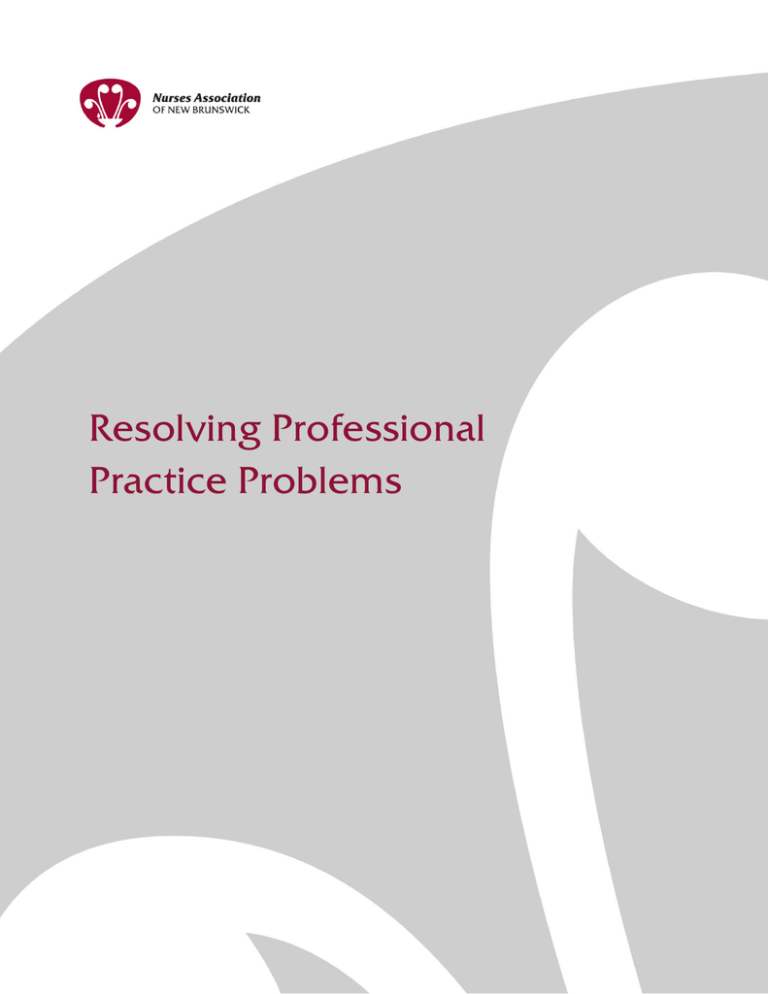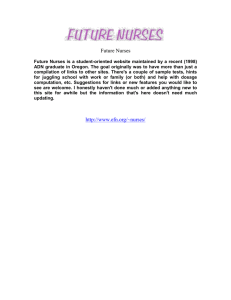
Resolving Professional
Practice Problems Resolving Professional Practice Problems February 2014 (1/10) Mission
The Nurses Association of New Brunswick is a professional regulatory organization that exists to protect the public and to support nurses by promoting and maintaining standards for nursing education and practice, and by promoting healthy public policy. © NURSES ASSOCIATION OF NEW BRUNSWICK 2014 All rights reserved. No part of this publication may be reproduced or transmitted in any form or by any means, electronic or mechanical, including photocopying, recording, or by any information storage and retrieval system, without prior written permission from the publisher. ISBN 1 895613‐60‐4 *For this document, the term registered nurse includes nurse practitioners Resolving Professional Practice Problems February 2014 (2/10) INTRODUCTION
Registered nurses (RNs) are accountable for decisions that are consistent with safe, competent, and ethical practice. The goal of nursing practice is to achieve the best possible health outcome for the client, with no unnecessary exposure to risk or harm. This document offers a step by step process that can be used as a guide to assist RNs in resolving professional practice problems. RESOLVING PROFESSIONAL PRACTICE PROBLEMS:
ADVOCATING FOR CLIENTS Professional Practice Problems: Any situation in the workplace that has or could place clients at risk by interfering with the RNs’ ability to practise in accordance with the Standards of Practice for Registered Nurses, the Code of Ethics for Registered Nurses, the Nurses Act or other legislation, workplace policies, procedures or other relevant standards and guidelines. The Standards of Practice for Registered Nurses (2012) require that registered nurses take action and report situations that put clients at risk, and advocate for and contribute to quality professional practice environments. This expectation is also echoed in the Code of Ethics for Registered Nurses which states that RNs advocate for and collaborate with clients in situation where there is a safety issue. Advocating is further defined in the Code of Ethics as…’’ actively supporting a right and good cause; supporting others in speaking for themselves or speaking on behalf of those who cannot speak for themselves’’. These expectations apply to all RNs in every role and setting. Problems of a professional practice nature are identified as: any situation in the workplace that has or could place clients at risk by interfering with the RNs’ ability to practise in accordance with the Standards of Practice for Registered Nurses, the Code of Ethics for Registered Nurses, the Nurses Act or other legislation, workplace policies, procedures or other relevant standards and guidelines. A professional practice problem is beyond the ability of an individual RN to resolve and requires that it be referred to the appropriate person. A professional practice problem is not a labor relation issue, a personal problem in the workplace or a performance issue. Resolving Professional Practice Problems February 2014 (3/10) Examples of professional practice problems include, but are not limited to:
Practice environments not supportive of RNs in meeting the Standards of Practice for RN or the Code of Ethics for Registered Nurses;
Working with limited resources;
Another RN’s or health care provider’s non‐compassionate, unethical or incompetent practice;
Lack of written policies/leadership to provide direction for nursing practice;
Lack of appropriate supplies or equipment;
Lack of access to essential medical or other health care professionals to meet client care needs;
Inadequate communication/documentation systems to support decision‐making about client care;
Conflict between care providers. STEPS FOR ACTION
STEP 1: Define the problem Clearly defining the professional practice problem is critical to its resolution. The following questions can be used when defining the problem:
Does the problem interfere with the RN’s ability to practise according to the Standards of Practice for Registered Nurses, Code of Ethics for Registered Nurses, Nurses Act or other relevant legislation and specific workplace policies/procedures? What are the risks to clients if the problem is not corrected? Date, time, place and who was involved? Is this a recurring problem? Are there common factors contributing to the situation and if so, what are they: people, context? Does the absence of a workplace policy/procedure contribute to this problem? Resolving Professional Practice Problems February 2014 (4/10) STEP 2: Communicate the problem Once the professional practice problem has been defined, it must be communicated utilizing the established lines of communication in the workplace so that it can be reviewed and action taken to address the issue. Most of the time, the first communication will be with the RN’s direct manager or supervisor. Suggested course of action to help communicate the issue: Ask the manager/supervisor/appropriate person for a meeting to discuss the problem; Explain how the problem puts clients at risk and interferes with the ability to meet NANB’s Standards of Practice for Registered Nurses, the Code of Ethics for Registered Nurses or employer policies; Be specific and factual, include all relevant information; Listen with an open mind to the manager’s perspective and pay attention to any new information provided; Be prepared to work together to resolve the problem, recognizing that some negotiation and compromise may be necessary; Work together to confirm the next steps. STEP 3: Document the problem If verbal communications with the manager/supervisor/appropriate person have not helped resolve the problem, give the manager/supervisor/appropriate person a detailed written statement. Workplaces may have designated forms for this purpose, such as incident or other reports. Where these exist, RNs should use these forms to document the situation. If there are no such reporting tools in the workplace, a letter or memo is appropriate (see sample letter in Appendix A). RNs may choose to complete the workplace form and include additional documentation, such as a letter or memo. Ensure that written communication is signed, dated, marked confidential and includes a request for a response by a specific date, taking into consideration the degree of urgency of the problem. A copy of this correspondence should be kept. Resolving Professional Practice Problems February 2014 (5/10) The written report should include: An explanation of the situation and factors that contribute to the professional practice problem as defined in Step 1; A reiteration of the impact, or potential impact on clients and/or on nursing practice; A list of standards or policies which were not being met; A description of actions taken in relation to the problem; Recommendations of actions required by the organization within a specific and reasonable time frame. If you do not receive a response by the requested date, inquire as to what progress is being made. If there is no resolution, be prepared to take your concerns to the next level of management by: Sending a second letter/memo to the same individual, stating this is in follow up to the earlier letter, which is enclosed in this correspondence; forward copies to the next highest level of management in the organization (this would normally be the individual to whom immediate manager/supervisor/appropriate person reports) and ensure a copy of this correspondence is kept on record; and Keeping a detailed record of all conversations and written communications surrounding this issue, actions/decisions taken and any results. STEP 4: Assess the outcome Resolution of the professional practice problem is the expected outcome. Resolution may take time but the problem should be resolved as soon as possible in order to minimize risks to clients. In order to expedite the resolution, offer to continue to participate in resolving the problem. Professional practice problems should be communicated and documented each time they occur. Resolving Professional Practice Problems February 2014 (6/10) 4 STEP PROCESS:
Other Resources
The following documents may be of assistance in resolving professional practice problems: Code of Ethics for Registered Nurses (CNA, 2008) Standards of Practice for Registered Nurses (NANB, 2012) NANB Brochure: When RNs are Expected to Work with Limited Resources (2013) Framework for a Quality Professional Practice Environment for Registered Nurses (NANB, 2009) Quality Practice Environments for Registered Nurses‐Position Statement (NANB, 2011) Patient Safety‐ Position Statement (NANB, 2009). INFOLaw: The Nurse as an Advocate. (CNPS, 2013) Resolving Professional Practice Problems February 2014 (7/10) References
Canadian Nurses Association (2008). The Code of Ethics for Registered Nurses. Ottawa: Author. Canadian Nurses Protective Society (2012). INFOLaw: The Nurse as an Advocate. Ottawa: Author. Nurses Association of New Brunswick (2012). Standards of Practice for Registered Nurses. Fredericton: Author. Nurses Association of New Brunswick (2011). Quality Practice Environment for Registered Nurses: Position Statement. Fredericton: Author. Nurses Association of New Brunswick and New Brunswick Nurses Union (2013). Brochure: When RNs are Expected to Work with Limited Resources. Fredericton: Authors. Resolving Professional Practice Problems February 2014 (8/10) Appendix A: Sample Correspondence
CONFIDENTIAL Date (day/month/year) Jane Doe, RN Program Manager, Surgery ABC Health Authority Somewhere, NB Dear Ms. Doe: This letter is in follow up to our discussion on (date) concerning the professional practice problem related to (specify the situation) with the …. (give specifics as to where this problem is evident, for example, the specific program/unit). I have observed /been witness to/experienced the following…... (detail the issue) on (where, when, who was present/involved). This is a recurring problem which, if left unresolved, poses a risk to clients by… (details) ‐or‐
compromises RNs’ ability to practice according to professional standards/Code of Ethics/ workplace policy/procedure (specify which ones). I am requesting that …...(specify what action is expected to be required) be taken to bring a quick resolution to this problem‐or‐that the Professional Practice Committee review and propose a solution to this problem. I would appreciate a response by (date) relative to the action being taken to respond to my concerns. Thank you for your assistance in this matter. I look forward to the opportunity, where possible, to participate in the resolution of this professional practice problem. Sincerely, Resolving Professional Practice Problems February 2014 (9/10) 165 Regent Street Fredericton, NB, E3B 7B4 Canada Tel.: 506‐458‐8731 Toll‐free: 1‐800‐442‐4417 www.nanb.nb.ca Resolving Professional Practice Problems February 2014 (10/10)

